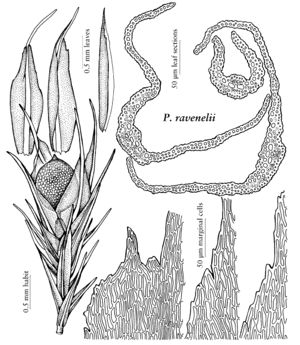Difference between revisions of "Pleuridium ravenelii"
Bull. Torrey Bot. Club 6: 142. 1877,.
FNA>Volume Importer |
imported>Volume Importer |
||
| Line 45: | Line 45: | ||
|publication year= | |publication year= | ||
|special status= | |special status= | ||
| − | |source xml=https:// | + | |source xml=https://bibilujan@bitbucket.org/aafc-mbb/fna-data-curation.git/src/bb6b7e3a7de7d3b7888a1ad48c7fd8f5c722d8d6/coarse_grained_fna_xml/V27/V27_673.xml |
|genus=Pleuridium | |genus=Pleuridium | ||
|species=Pleuridium ravenelii | |species=Pleuridium ravenelii | ||
Revision as of 22:34, 27 May 2020
Stem leaves erect, concave, lamina juxtacostally 2-stratose, becoming 1-stratose towards margin; proximal leaves minute, bract-like, narrowly deltoid, acuminate, 0.53–0.85 × 0.15–0.25 mm, entire; distal stem leaves ovate to lanceolate, acuminate to subulate, 1.05–1.75 × 0.2–0.38 mm, entire; costa broad, percurrent to excurrent. Sexual condition paroicous, antheridia naked in the distal leaf axils just proximal to the perichaetium. Perichaetial leaves oblong to obovate-lanceolate proximally, carinate-acuminate distally, gradually narrowed to a broad, channeled to subtubulose acumen which is generally shorter than the leaf base, 1.58–2.63 × 0.43–0.58 mm, margins serrulate to serrate, erect to incurved distally, coarsely and irregularly to distinctly jaggedly toothed at shoulder; lamina plicate to pleated; basal cells oblong to rectangular; median cells subquadrate to short-rectangular; distal cells at shoulder longer, long-rhomboidal to curved linear; costa excurrent with a conduplicate or canaliculate awn, broad, smooth on back, indistinct at mid leaf, confluent with the juxtacostal part of lamina, filling most of the acumen; transverse section of costa at mid leaf with adaxial guide cells and abaxial stereid cells forming wide rows across the width with the central accessory cells forming an aperture; innermost perichaetial leaves ovate-acuminate, percurrent. Seta 0.15–0.2 mm. Spores (32–)37.5–42.5 µm, bluntly and finely papillose, yellow to orange in mass.
Phenology: Capsules mature Mar–Jun.
Habitat: Bare sandy soil, open spaces of scrub oak association
Elevation: low to moderate elevations
Distribution

Ala., Ark., Del., Fla., Ga., La., Mass., Mo., N.J., N.C., Okla., Pa., R.I., S.C., Tex., W.Va.
Discussion
The chromosome number of Pleuridium ravenelii is n = 13 (North Carolina, H. A. Crum and L. E. Anderson 1981). The species is characterized by (1) plicate leaf lamina (most easily observed in transverse sections), (2) lamina outwardly 1-stratose but 2-stratose on either side of the costa, (3) channeled distal portion of costa, and (4) coarsely toothed shoulder. Serrations of the leaf shoulder, however, vary from minimally toothed with projecting ends of marginal cells to abruptly exaggerated (“jagged shoulders,” Crum and Anderson). Though not always obvious because of the plicate lamina and the canaliculate costa, the jaggedly toothed shoulders are most pronounced in outer perichaetial leaves. The spores are the largest in the genus, as initially described by Austin. Early American bryologists (e.g., S. Watson in W. H. Brewer et al. 1876–1880, vol. 2; C. L. Lesquereux and T. P. James 1884) considered P. ravenelii a taxon intergrading with P. acuminatum because of the intermediate leaf shape. Crum and Anderson suggested that P. ravenelii is an extreme habitat response of P. acuminatum populations along the coastal sand dunes of eastern North America. Most specimens examined are, indeed, from such characteristic habitats of the southeastern Coastal Plain. An occasional specimen may resemble P. acuminatum or P. subulatum in general habit. For instance, a specimen from Florida (Breen 2930, NY) has an ovate-lanceolate leaf base with narrowly acuminate tips and is 1-stratose in the portion of the lamina towards the margins (and is therefore close to P. subulatum), but (1) the carinate acumen (clearest in the characteristic transverse section), (2) the jagged teeth at leaf shoulders (usually obscure because hidden by the conduplicate costa and the plicate lamina), and (3) the juxtacostally 2-stratose leaf lamina support its identification as P. ravenelii.
Selected References
None.
